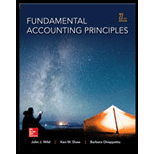
1)
Introduction:
Salaries and Tax deductions:
• Salaries expense for an employer comprises of cost of salaries paid and cost of employee benefits and payroll taxes incurred.
• Cost of employee benefits and payroll taxes incurred consist of FICA Tax i.e. Federal Insurance Contributions Act Tax,
• Net salary is calculated as Gross Salary Less Cost of employee benefits and payroll taxes incurred. FICA Tax is calculated as 6.2 % Social Security and 1.45% Medicare totaling up to 7.65% for both employer and employee for a total FICA Tax of 15.30%
• Unemployment tax comprises of 6% Federal Unemployment Tax and State Unemployment Tax at 5.4%.
To Determine:
Gross pay, payroll deductions and Net pay
2)
Introduction:
Salaries and Tax deductions:
• Salaries expense for an employer comprises of cost of salaries paid and cost of employee benefits and payroll taxes incurred.
• Cost of employee benefits and payroll taxes incurred consist of FICA Tax i.e. Federal Insurance Contributions Act Tax, Unemployment tax, insurance expenses and retirement benefits expense incurred for the employees.
• Net salary is calculated as Gross Salary Less Cost of employee benefits and payroll taxes incurred.
• FICA Tax is calculated as 6.2 % Social Security and 1.45% Medicare totaling up to 7.65% for both employer and employee for a total FICA Tax of 15.30%
• Unemployment tax comprises of 6% Federal Unemployment Tax and State Unemployment Tax at 5.4%.
Journal Entries
• Journal entries are the first step in recording financial transactions and preparation of financial statements.
• These represent the impact of the financial transaction and demonstrate the effect on the accounts impacted in the form of debits and credits.
• Assets and expenses have debit balances and Liabilities and Incomes have credit balances and according to the business transaction, the accounts are appropriately debited will be credited by credited to reflect the effect of business transactions and events.
To Determine:
3)
Introduction:
Salaries and Tax deductions:
• Salaries expense for an employer comprises of cost of salaries paid and cost of employee benefits and payroll taxes incurred.
• Cost of employee benefits and payroll taxes incurred consist of FICA Tax i.e. Federal Insurance Contributions Act Tax, Unemployment tax, insurance expenses and retirement benefits expense incurred for the employees.
• Net salary is calculated as Gross Salary Less Cost of employee benefits and payroll taxes incurred. FICA Tax is calculated as 6.2 % Social Security and 1.45% Medicare totaling up to 7.65% for both employer and employee for a total FICA Tax of 15.30%
• Unemployment tax comprises of 6% Federal Unemployment Tax and State Unemployment Tax at 5.4%.
Journal Entries
• Journal entries are the first step in recording financial transactions and preparation of financial statements.
• These represent the impact of the financial transaction and demonstrate the effect on the accounts impacted in the form of debits and credits.
• Assets and expenses have debit balances and Liabilities and Incomes have credit balances and according to the business transaction, the accounts are appropriately debited will be credited by credited to reflect the effect of business transactions and events.
To Determine:
Journal entry to record payroll tax expense
4)
Introduction:
Journal Entries
• Journal entries are the first step in recording financial transactions and preparation of financial statements.
• These represent the impact of the financial transaction and demonstrate the effect on the accounts impacted in the form of debits and credits.
• Assets and expenses have debit balances and Liabilities and Incomes have credit balances and according to the business transaction, the accounts are appropriately debited will be credited by credited to reflect the effect of business transactions and events.
To Determine:
Journal entry to record transaction of sale of merchandise with 4% sales tax
Want to see the full answer?
Check out a sample textbook solution
Chapter 11 Solutions
Fundamental Accounting Principles -Hardcover
- Elmont Industries issues $2,400,000 of 8% bonds at 101. What is the amount of cash Elmont would receive from the sale? A. $2,373,000 B. $2,240,000 C.$2,424,000 D. $2,185,000 E. None of the above. Help mearrow_forwardPlease explain how to solve this financial accounting question with valid financial principles.arrow_forwardCan you help me solve this general accounting problem with the correct methodology?arrow_forward

 AccountingAccountingISBN:9781337272094Author:WARREN, Carl S., Reeve, James M., Duchac, Jonathan E.Publisher:Cengage Learning,
AccountingAccountingISBN:9781337272094Author:WARREN, Carl S., Reeve, James M., Duchac, Jonathan E.Publisher:Cengage Learning, Accounting Information SystemsAccountingISBN:9781337619202Author:Hall, James A.Publisher:Cengage Learning,
Accounting Information SystemsAccountingISBN:9781337619202Author:Hall, James A.Publisher:Cengage Learning, Horngren's Cost Accounting: A Managerial Emphasis...AccountingISBN:9780134475585Author:Srikant M. Datar, Madhav V. RajanPublisher:PEARSON
Horngren's Cost Accounting: A Managerial Emphasis...AccountingISBN:9780134475585Author:Srikant M. Datar, Madhav V. RajanPublisher:PEARSON Intermediate AccountingAccountingISBN:9781259722660Author:J. David Spiceland, Mark W. Nelson, Wayne M ThomasPublisher:McGraw-Hill Education
Intermediate AccountingAccountingISBN:9781259722660Author:J. David Spiceland, Mark W. Nelson, Wayne M ThomasPublisher:McGraw-Hill Education Financial and Managerial AccountingAccountingISBN:9781259726705Author:John J Wild, Ken W. Shaw, Barbara Chiappetta Fundamental Accounting PrinciplesPublisher:McGraw-Hill Education
Financial and Managerial AccountingAccountingISBN:9781259726705Author:John J Wild, Ken W. Shaw, Barbara Chiappetta Fundamental Accounting PrinciplesPublisher:McGraw-Hill Education





